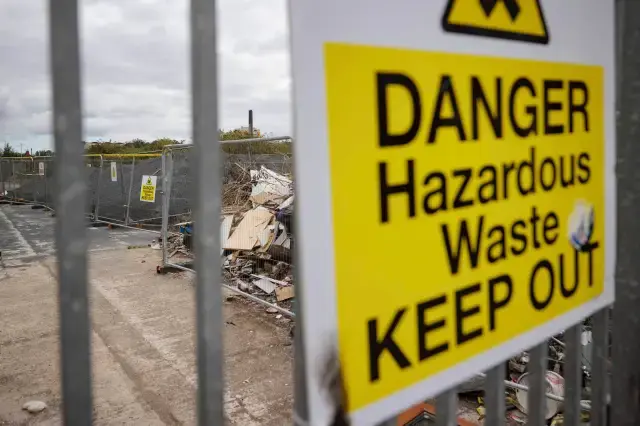New EPA Rule Could Allow More Use of Toxic Chemicals – Newsweek

Report on Proposed EPA Rule Change to the Toxic Substances Control Act (TSCA)
Executive Summary
A new rule proposed by the Environmental Protection Agency (EPA) seeks to alter the evaluation process for toxic chemicals under the Toxic Substances Control Act (TSCA). This report analyzes the proposed changes and their significant implications for several United Nations Sustainable Development Goals (SDGs), particularly SDG 3 (Good Health and Well-being), SDG 8 (Decent Work and Economic Growth), SDG 12 (Responsible Consumption and Production), and SDG 16 (Peace, Justice and Strong Institutions).
Analysis of Proposed Changes and Impact on Sustainable Development Goals
SDG 3: Good Health and Well-being & SDG 12: Responsible Consumption and Production
The proposed rule fundamentally changes how chemical risks are assessed, moving from a comprehensive evaluation to a conditional one. This shift directly challenges the principles of SDG 3.9, which aims to reduce illnesses from hazardous chemicals, and SDG 12.4, which calls for the environmentally sound management of chemicals to minimize adverse impacts on human health.
- Conditional Use Assessment: The EPA would gain the authority to determine that a toxic chemical, such as asbestos or lead, is safe for use in specific circumstances. This piecemeal approach contrasts with the previous “whole chemical” evaluation, which considered aggregate exposure from multiple sources.
- Selective Pathway Review: The rule would allow the EPA to decide which exposure pathways (e.g., air, water, consumer products) it reviews. Critics argue this could lead to an underestimation of total public exposure, as not all potential routes of contamination would be mandatorily assessed.
- Risk to Public Health: Experts express concern that these changes will make it easier for manufacturers to market products without adequate risk assessment, potentially reintroducing public health tragedies associated with substances like asbestos and benzene. This directly undermines progress toward ensuring healthy lives and promoting well-being for all.
SDG 8: Decent Work and Economic Growth
The proposal introduces significant changes to the evaluation of occupational risk, impacting the achievement of SDG 8.8, which focuses on protecting labor rights and promoting safe and secure working environments.
- Assumption of Protective Equipment: The new rule would permit the EPA to assume that workers consistently and correctly use Personal Protective Equipment (PPE) when calculating risk. The previous rule limited this assumption.
- Weakened Worker Protections: Critics, including Professor Rena Steinzor, argue that this change scraps the requirement to assess whether workers have adequate protections on the factory floor, a key component of the 2016 TSCA amendments.
- Potential for Increased Occupational Illness: By potentially underestimating workplace exposure, the rule could lead to an increase in occupational diseases, directly conflicting with the goal of ensuring decent and safe work for all.
SDG 16: Peace, Justice and Strong Institutions
The rationale and process behind the proposed rule raise questions related to institutional accountability and transparency, a cornerstone of SDG 16.6.
- Regulatory Rollback: The proposal reverses more protective rules implemented by the previous administration. Legal expert Cary Coglianese notes that the EPA is justifying this by claiming a new “best reading” of the statute without any change in the law itself, suggesting the shift is driven by policy preference rather than legal necessity.
- Concerns of Industry Influence: Professor Noah Sachs highlights that the changes align with a “wish list” from industry groups and that the EPA’s chemicals office is now led by former industry executives and lobbyists, raising concerns about the institution’s ability to regulate impartially.
- Justification vs. Reality: The EPA states the rule will increase efficiency. However, critics contend that program delays are primarily due to insufficient staffing, budget cuts, and industry litigation, not the regulations themselves. This discrepancy challenges the transparency and effectiveness of the institution.
Official Justification and Next Steps
EPA Position
The EPA asserts that the proposed rule provides a “clear, predictable, commonsense approach” that will protect human health while allowing the manufacturing sector to thrive. The agency maintains that it will still determine if a chemical presents an “unreasonable risk” by considering hazard severity, exposure, and the affected population.
Public Response and Timeline
The proposal is open for public comment. Initial feedback expresses concern that the changes will underestimate chemical risks and prioritize business profits over public health and environmental safety. The final rule is anticipated in 2026, after which legal challenges from environmental and public health organizations are expected.
Analysis of Sustainable Development Goals in the Article
1. Which SDGs are addressed or connected to the issues highlighted in the article?
The article on the EPA’s proposed rule for regulating toxic chemicals connects to several Sustainable Development Goals (SDGs) that focus on health, environmental protection, safe working conditions, and institutional integrity.
- SDG 3: Good Health and Well-being: The primary focus of the article is the potential impact of the new rule on public health. It discusses the risks associated with toxic chemicals like asbestos, formaldehyde, mercury, and lead, and quotes an expert warning that tragedies like “black lung disease, benzene exposure, and inhalation of asbestos could all be duplicated.”
- SDG 8: Decent Work and Economic Growth: The article explicitly addresses the implications for worker safety. It highlights a change in how the EPA would consider risks to workers, specifically by being allowed to assume the use of personal protective equipment, which could weaken protections on the “factory floor.”
- SDG 12: Responsible Consumption and Production: The article is centered on the management of hazardous chemicals. The proposed rule alters the “Procedures for Chemical Risk Evaluation Under the Toxic Substances Control Act (TSCA),” which directly relates to the goal of achieving environmentally sound management of chemicals throughout their life cycle to minimize adverse impacts.
- SDG 16: Peace, Justice and Strong Institutions: The article questions the effectiveness, accountability, and transparency of the EPA. It mentions concerns about “insufficient staffing and budgets,” the influence of industry lobbyists, and a rapid change in the legal interpretation of the TSCA statute, all of which relate to the strength and integrity of public institutions.
2. What specific targets under those SDGs can be identified based on the article’s content?
Based on the issues discussed, the following specific SDG targets are relevant:
- Target 3.9: “By 2030, substantially reduce the number of deaths and illnesses from hazardous chemicals and air, water and soil pollution and contamination.” The article’s entire premise revolves around the regulation of hazardous chemicals and the concern that weakening these regulations will put “Americans at risk” and fail to prevent illnesses associated with chemical exposure.
- Target 8.8: “Protect labour rights and promote safe and secure working environments for all workers…” The article directly addresses this target by explaining how the proposed rule would change risk assessment for workers. It notes that the new rule scraps the requirement that “EPA consider as part of the risk assessment whether chemical workers have adequate protections on the factory floor.”
- Target 12.4: “By 2020, achieve the environmentally sound management of chemicals and all wastes throughout their life cycle… and significantly reduce their release to air, water and soil in order to minimize their adverse impacts on human health and the environment.” The proposed changes to the TSCA risk evaluation process are central to this target. The debate over whether to assess a “whole chemical” or just specific “conditions of use” is a debate about how to best achieve sound management and minimize adverse impacts.
- Target 16.6: “Develop effective, accountable and transparent institutions at all levels.” The article implies a challenge to this target by citing expert opinions that the EPA is suffering from “shocking cutbacks in EPA staff, especially scientists” and that the rule change is driven by “a change in policy preferences by the new administration” rather than a new understanding of the law, raising questions about the institution’s effectiveness and accountability.
3. Are there any indicators mentioned or implied in the article that can be used to measure progress towards the identified targets?
The article does not mention official SDG indicators, but it implies several metrics that could be used to measure progress:
- For Target 3.9: An implied indicator is the incidence of diseases linked to toxic chemical exposure. The article explicitly names “black lung disease, benzene exposure, and inhalation of asbestos” as potential consequences, suggesting that tracking the rates of these occupational and environmental illnesses would be a key measure of the effectiveness of chemical safety regulations.
- For Target 8.8: A relevant indicator is the stringency and enforcement of occupational safety regulations regarding chemical exposure. The article discusses the rule change that would allow the EPA to “assume that workers always use personal protective equipment when calculating risk.” Progress could be measured by whether regulations mandate the consideration of actual working conditions versus assumptions.
- For Target 12.4: An implied indicator is the comprehensiveness of chemical risk evaluations. The article contrasts the Biden administration’s “whole chemical” approach, which requires the agency to “consider every condition of use and every exposure route and pathway,” with the proposed rule that allows the EPA to be selective. Therefore, the number or percentage of chemicals evaluated under a comprehensive, multi-pathway framework would be a direct indicator of progress.
- For Target 16.6: The article points to the budget and staffing levels of regulatory agencies like the EPA as a key indicator of institutional capacity. The expert quote about “insufficient staffing and budgets” and “cutbacks in EPA staff, especially scientists” suggests that these resources are a direct measure of the institution’s ability to “conduct independent evaluations of toxic chemicals” effectively.
4. Summary of SDGs, Targets, and Indicators
| SDGs | Targets | Indicators (Implied from Article) |
|---|---|---|
| SDG 3: Good Health and Well-being | 3.9: Substantially reduce deaths and illnesses from hazardous chemicals and pollution. | Incidence rates of diseases linked to specific toxic chemicals (e.g., black lung disease, illnesses from asbestos, benzene). |
| SDG 8: Decent Work and Economic Growth | 8.8: Protect labour rights and promote safe and secure working environments for all workers. | Regulations governing the assessment of chemical exposure risks to workers, specifically whether they are based on actual conditions or assumptions about protective equipment use. |
| SDG 12: Responsible Consumption and Production | 12.4: Achieve the environmentally sound management of chemicals and all wastes throughout their life cycle. | The number of chemicals evaluated using a comprehensive “whole chemical” approach that considers all potential exposure pathways. |
| SDG 16: Peace, Justice and Strong Institutions | 16.6: Develop effective, accountable and transparent institutions at all levels. | Annual budget and staffing levels (particularly scientific staff) for the environmental protection agency’s chemical safety programs. |
Source: newsweek.com
What is Your Reaction?
 Like
0
Like
0
 Dislike
0
Dislike
0
 Love
0
Love
0
 Funny
0
Funny
0
 Angry
0
Angry
0
 Sad
0
Sad
0
 Wow
0
Wow
0
















































:focal(1500,1000)/https://media.globalcitizen.org/a6/9a/a69a4720-d8a1-4715-b596-18738d03c05c/rotary_polio_hero_image.jpg?#)







/countries/sri-lanka/photo-credit---dmc-sri-lanka.tmb-1200v.jpg?sfvrsn=dc298bcc_1#)


















